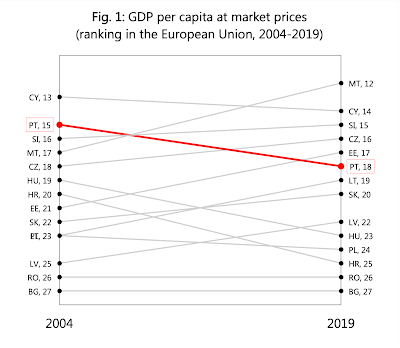Portugal's economy: continuously outperformed by former USSR economies?
Premise: Almost all political candidates argued that while the Portuguese economy converged with the European one, it was still outperformed by those from the former USSR economies that joined the European Union since 2004.
The European Union membership expanded by 13 members (from 15 to 28, now 27) since 2004. These were:
2004:
- Czech Republic (CZ)
- Cyprys (CY)
- Estonia (EE)
- Hungary (HU)
- Latvia (LV)
- Lithuania (LT)
- Malta (MT)
- Poland (PL)
- Slovakia (SK)
- Slovenia (SI)
2007:
- Bulgaria (BG)
- Romania (RO)
2013:
- Croatia (HR)
Of these, only the Czech Republic, Hungary, Poland, and Romania have not adopted the Euro as their currency.
Let's assume politicians use GDP per capita (at market values) as the metric of choice. In that case, Portugal went from being the 15th richest country in the EU-27 in 2004 to the 18th in 2019.
Between 2012 and 2019, four countries overtook Portugal in the ranking: Malta (17th to 12th), Slovenia (16th to 15th), Czech Republic (18th to 16th), and Estonia (21st to 17th). Meanwhile, Portugal overtook Greece (14th to 21st) during the period, a movement that happened in almost all rankings going forward.
Comparing countries using market prices does have some methodological issues. To account for price and exchange rate differences among economies, we tend to use values in purchasing power parity (PPP). This will be the methodology used onwards. In that case, Portugal still ends up being overtaken by three countries (Lithuania, Estonia, and the Czech Republic) and overtakes Greece.
However, using GDP as a metric is just one choice and could easily be substituted by another. Gross National Income (GNI) has become a popular alternative to GDP, calculating income instead of output. (see methodological notes for how to get GNI)
GNI has become the favorite measure for countries' wealth at the World Bank. More importantly, it is also used by the EU to calculate the contributions of member countries. Using GNI per capita in PPP terms, Portugal ends up maintaining the same ranking (between 2017 and 2019) and is in line with GDP per capita in PPP terms at 19th place.
But maybe we don't want to look at production or income aggregates. A typical alternative is to use consumption per capita. If that is the chosen metric, we get a very different picture, with Portugal maintaining the same 15th place in the EU from 2004 to 2019.
Or maybe, we would prefer looking at compensation per employee, in which case Portugal loses one place in the ranking.
The country loses two places if instead, we use compensation per hour worked, on the account of Portugal going from 8th to 4th place in hours worked per employee (2012 to 2019).
However, I would argue that none of these metrics is particularly interesting or tells anything about the future of the economy. Instead of looking at whether or not a country maintains a ranking on some subjective production or income metric, I would argue that politicians should focus on productivity growth.
Unfortunately, Portugal has a structural problem when it comes to productivity, constantly lagging most economies. Between 2012 and 2019, real labor productivity per capita grew 4.8% in Portugal, the 10th lowest in the EU (average of 4%).
As mentioned above, Portugal's ranking in hours worked per employee grew 4 positions. In fact, total hours worked increased by almost 40 hours per employee during that period (i.e., an extra week of work). If we take into consideration the extra hours worked, real labor productivity during the period 2012-2019 grew only 2.7%, the 5th lowest in the EU, and almost half the EU average (5.1%), an extremely dismal result.
Hopefully, next elections we will see a wider debate about the continuously low productivity growth and low levels of education, instead of focusing only on who surpasses the country on subjective metrics.
Conclusion: Idependently of the preferred metric, Portugal has been surpassed in the European rankings by some of the former USSR economies. In the best case scenario, it was able to maintain its ranking. That being said, this debate should probably explore why we maintain low economic growth, low productivity growth, and low levels of education, and focus less on who surpassed us.
_______
Methodological notes: Data source is from Eurostat, with some calculations by the author.
To calculate GNI, compensation paid to resident employees by foreign firms and income from overseas property owned by residents is added to GDP, while compensation paid by resident firms to overseas employees and income generated by foreign owners of domestic property is subtracted. Product and import taxes that are not already accounted for in GDP are also added to GNI, while subsidies are subtracted.









Comments
Post a Comment